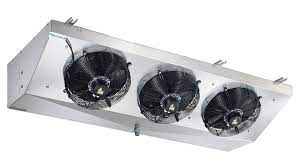What is Cold Room Evaporator?
A cold room evaporator is a device that is used to cool and maintain the temperature inside a cold storage room or a walk-in freezer. It is an integral part of the refrigeration system, which works by circulating a refrigerant through a coil, where it absorbs heat from the air in the room and then transfers that heat to the condenser, where it is dissipated. This process causes the temperature inside the cold room to drop and remain at a desired level.
Cold room evaporators come in different types and sizes, depending on the application and cooling requirements. They can be ceiling-mounted, wall-mounted, or floor-mounted, and may use different types of coils, such as copper, aluminum, or stainless steel. Proper installation, sizing, and maintenance of the cold room evaporator are crucial for ensuring efficient and reliable operation of the refrigeration system and maintaining the quality and safety of the stored products.
Types of Cold Room Evaporators
There are several types of cold room evaporators available, each with its own advantages and disadvantages. Here are some common types:
Air-cooled evaporators:
These evaporators use fans to blow air over the refrigerant coils, which then absorb heat from the air in the cold room. Air-cooled evaporators are simple and cost-effective, but may not be suitable for larger cold rooms or applications where precise temperature control is required.
Water-cooled evaporators:
These evaporators use water to absorb heat from the refrigerant coils, which then flows through a cooling tower or other water-cooling system. Water-cooled evaporators can provide more precise temperature control and are often used in larger cold room applications, but can be more expensive and complex to install.
Remote evaporators:
These evaporators are installed outside of the cold room and are connected to it through refrigerant lines. Remote evaporators can provide more flexibility in cold room design and placement, and can be easier to access for maintenance, but can also be more expensive to install and require more refrigerant.
Hot gas defrost evaporators:
These evaporators use hot gas from the refrigeration system to defrost the coils, rather than relying on electric heaters. Hot gas defrost evaporators can be more energy-efficient and provide faster defrost times, but may require more complex control systems.
Electric defrost evaporators:
These evaporators use electric heaters to defrost the coils. Electric defrost evaporators are simple and reliable, but may be less energy-efficient and require longer defrost times.
Blast freezers:
These are specialized evaporators designed to rapidly freeze products or raw materials in a cold room. Blast freezers typically have larger coils and more powerful fans to quickly reduce the temperature of the air in the cold room.
Features of Cold Room Evaporators?
Cold room evaporators have several features that make them an essential component of the refrigeration system in a cold room or walk-in freezer. Some of the key features of cold room evaporators include:
Coil material:
Cold room evaporators can be made of different materials, such as copper, aluminum, or stainless steel, depending on the application and the refrigerant being used.
Coil design:
The coils in cold room evaporators can be designed in different ways, such as tube-in-tube, plate, or finned, to optimize heat transfer and improve efficiency.
Fan type:
Cold room evaporators can have different types of fans, such as axial or centrifugal fans, to circulate the air inside the cold room.
Capacity:
Cold room evaporators are available in different capacities to meet the cooling requirements of various applications, from small walk-in coolers to large cold storage warehouses.
Mounting options:
Cold room evaporators can be ceiling-mounted, wall-mounted, or floor-mounted, depending on the available space and the requirements of the application.
Defrost options:
Cold room evaporators can have different defrost options, such as hot gas, electric, or water defrost, to prevent ice buildup on the coils and maintain optimal efficiency.
Control options:
Cold room evaporators can have different control options, such as thermostats or electronic controllers, to maintain the desired temperature and humidity levels inside the cold room.
Wall-mounted evaporators:
These evaporators are mounted on the walls of the cold room and are suitable for use in rooms where floor space is limited. They are commonly used in food processing plants, breweries, and other industrial settings.
Floor-mounted evaporators:
These evaporators are installed on the floor of the cold room and are suitable for use in large rooms or warehouses. They are designed to cool the air from the floor up and are commonly used in the storage of fruits, vegetables, and other perishable items.
Tube-in-tube evaporators:
These evaporators consist of two tubes, one inside the other, and are ideal for use in cold rooms where the humidity levels need to be kept high. They are commonly used in the storage of flowers, fruits, and vegetables.
Finned evaporators:
These evaporators consist of a series of fins that are attached to a tube and are used in cold rooms where the temperature needs to be kept low. They are commonly used in the storage of meat, fish, and other frozen products.
In summary, the type of cold room evaporator used depends on the specific requirements of the cold room, and proper selection of the evaporator type is important for maintaining the quality and safety of the stored products.
Conclusion
As a language model, I cannot draw conclusions in the traditional sense as I do not have personal opinions or beliefs. However, I can summarize the blog ideas related to cold room evaporators and suggest that these topics can be useful for individuals and businesses that work with cold storage or refrigeration systems. Understanding the importance, types, and common issues with cold room evaporators can help in selecting the right evaporator for specific applications, ensuring proper maintenance, and preventing breakdowns. Exploring the latest advancements in cold room evaporator technology can also help in improving energy efficiency and overall performance.








